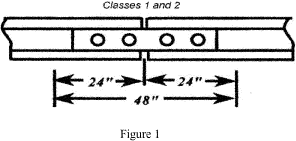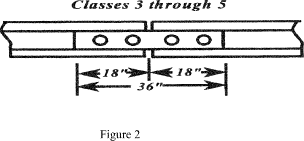Title 49
SECTION 213.109
213.109 Crossties.
§ 213.109 Crossties.(a) Crossties shall be made of a material to which rail can be securely fastened.
(b) Each 39-foot segment of track shall have at a minimum -
(1) A sufficient number of crossties that in combination provide effective support that will -
(i) Hold gage within the limits prescribed in § 213.53(b);
(ii) Maintain surface within the limits prescribed in § 213.63; and
(iii) Maintain alinement within the limits prescribed in § 213.55;
(2) The minimum number and type of crossties specified in paragraph (b)(4) of this section and described in paragraph (c) or (d), as applicable, of this section effectively distributed to support the entire segment;
(3) At least one non-defective crosstie of the type specified in paragraphs (c) and (d) of this section that is located at a joint location as specified in paragraph (e) of this section; and
(4) The minimum number of crossties as indicated in the following table.
| FRA track class | Tangent track, turnouts, and curves | |
|---|---|---|
| Tangent track and curved track less than or equal to 2 degrees | Turnouts and curved track greater than 2 degrees | |
| Class 1 | 5 | 6 |
| Class 2 | 8 | 9 |
| Class 3 | 8 | 10 |
| Class 4 and 5 | 12 | 14 |
(c) Crossties, other than concrete, counted to satisfy the requirements set forth in paragraph (b)(4) of this section shall not be -
(1) Broken through;
(2) Split or otherwise impaired to the extent the crosstie will allow the ballast to work through, or will not hold spikes or rail fasteners;
(3) So deteriorated that the crosstie plate or base of rail can move laterally 1/2 inch relative to the crosstie; or
(4) Cut by the crosstie plate through more than 40 percent of a crosstie's thickness.
(d) Concrete crossties counted to satisfy the requirements set forth in paragraph (b)(4) of this section shall not be -
(1) Broken through or deteriorated to the extent that prestressing material is visible;
(2) Deteriorated or broken off in the vicinity of the shoulder or insert so that the fastener assembly can either pull out or move laterally more than 3/8 inch relative to the crosstie;
(3) Deteriorated such that the base of either rail can move laterally more than 3/8 inch relative to the crosstie on curves of 2 degrees or greater; or can move laterally more than 1/2 inch relative to the crosstie on tangent track or curves of less than 2 degrees;
(4) Deteriorated or abraded at any point under the rail seat to a depth of 1/2 inch or more;
(5) Deteriorated such that the crosstie's fastening or anchoring system, including rail anchors (see § 213.127(b)), is unable to maintain longitudinal rail restraint, or maintain rail hold down, or maintain gage due to insufficient fastener toeload; or
(6) Configured with less than two fasteners on the same rail except as provided in § 213.127(c).
(e) Class 1 and 2 track shall have one crosstie whose centerline is within 24 inches of each rail joint (end) location. Class 3, 4, and 5 track shall have either one crosstie whose centerline is within 18 inches of each rail joint location or two crossties whose centerlines are within 24 inches either side of each rail joint location. The relative position of these crossties is described in the following three diagrams:
(1) Each rail joint in Class 1 and 2 track shall be supported by at least one crosstie specified in paragraphs (c) and (d) of this section whose centerline is within 48 inches as shown in Figure 1.

(2) Each rail joint in Class 3, 4, and 5 track shall be supported by either at least one crosstie specified in paragraphs (c) and (d) of this section whose centerline is within 36 inches as shown in Figure 2, or:

(3) Two crossties, one on each side of the rail joint, whose centerlines are within 24 inches of the rail joint location as shown in Figure 3.

(f) For track constructed without crossties, such as slab track, track connected directly to bridge structural components, track over servicing pits, etc., the track structure shall meet the requirements of paragraph (b)(1) of this section.
[76 FR 18084, Apr. 1, 2011]